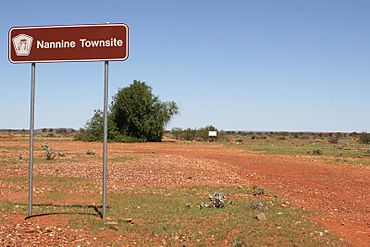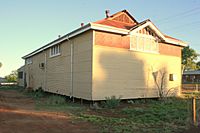Nannine, Western Australia facts for kids
Quick facts for kids NannineWestern Australia |
|
|---|---|

Nannine Townsite 2008
|
|
| Established | 1893 |
| Postcode(s) | 6642 |
| Elevation | 452 m (1,483 ft) |
| Location |
|
| LGA(s) | Shire of Meekatharra |
| State electorate(s) | North West |
| Federal Division(s) | Durack |
Nannine is a ghost town in the Mid West region of Western Australia. It is located on the northern bank of Lake Anneen, approximately 35 kilometres (22 mi) south-southwest of Meekatharra, and 735 kilometres (457 mi) north-northeast of Perth.
Nannine was a former gold mining town, the site of the first discovery on the Murchison Goldfield. John Connelly discovered gold at the site northeast of Annean Station in 1890, prompting a gold rush to the area. The Murchison Goldfield was proclaimed in September 1891 and the town gazetted in 1893. It was the first town in the region.
By 1894 the town was large enough to be given its own electoral district. In 1896 construction began on a railway between Nannine and Cue, Western Australia, which was completed in 1903. The continuation of the line to Meekatharra was begun in 1909.
Contents
History
Nannine is an Aboriginal name, "Nannine Wells" being first recorded by a surveyor in 1889. The meaning of the name is not known. The earliest days of gold discovery at this site are shrouded in controversy, but according to one source it is likely that the first suspicions of gold in the area were apparently held by Ingpen and Watts, station hands on the Annean pastoral station. In about May 1890 they showed the site to J. F. Connolly, a New South Wales mining engineer, who found gold but he does not appear to have been too impressed. In October 1890 McPherson and Peterkin were directed to the same site and found significant quantities of gold. By August 1891 they and others had recovered about 1,700 ounces of gold. The Murchison Goldfield, which included Nannine was proclaimed in September 1891. By December about seven hundred men were at the field.
The original settlement was down in a gully area between the later town and the mines to the east and north of the town. In 1892 John Forrest, the Commissioner for Crown Lands decided to have lots surveyed and a townsite declared, although Forrest referred to the place as "Annean", the name of the nearby pastoral station. When the local miners heard the auction of lots was to be in Perth, eighty five of them petitioned Forrest to have the auction in Geraldton. The lots were surveyed in August 1892, and the townsite named Nannine, as "it is situated 10 miles from Annean Station and 3 miles from Nannine Wells", and was also the name of the proposed electoral district and adjacent gold mining lease. The townsite was gazetted in April 1893. Following the survey and the release of the town blocks for purchase, many if not all of the existing premises including the businesses moved to the official townsite. Exactly how rapidly this migration occurred is not known, but it was apparently complete by 1896/7. This may have resulted in some businesses closing down, not wishing to make the move to rated land.
The town and surrounding area was inundated by heavy rains in 1913, Nannine receiving 1.82 inches (46 mm) in a day, causing the railway line to Meekatharra to be flooded and creating a washway a few miles north of the town.
By 1919 the town was in deep decline.
Utilities
In November 1906 the town water supply was opened.
Mining Warden
By 1893 the Wardens Court was still a tent with a notice board at the front, but fortunately construction began on a stone building for the Warden's Court and Registrars office in March 1896.
Walters, W. A. G. – The first mining Warden at Nannine. He arrived in September 1891.
Transport services
In January 1892 Spalding began a coach service from Mingenew to Annean and Marsh ran one from Geraldton to Nannine from July the same year. In 1897 the postal directory records twice weekly Gascard coaches from Yalgoo. The West Australian Tuesday 6 January 1903 records the opening of the 'railway line from Cue to Nannine'.
Postal & Communication Services
A telegraph line to Geraldton commenced service in November 1894. Work on the stone post and telegraph building began in March 1896 at the corner of Marmion & McPherson Streets in 1896/7.
Twine, A. C. – He is listed as the Postmaster in the 1897 postal directory.
Halls and churches
A timber and iron Miners Institute was erected in 1896. The only church building to that date in the town Roman Catholic. The Miners Institute hall was handed over to the Municipal Council to manage in 1910.
The Masonic Hall
Freemasonry was a significant part of the social fabric of many rural and remote towns across Australia during the first half of the 20th century. The Masonic Hall was originally built in Nannine around 1900, and then transported to Meekatharra when Nannine began to fade some 20 years later. In listing the building on its Register, the Heritage Council of WA depicts it as being of "Federation Gothic" architectural style. It lists the building's "Historic Themes" as being "social and civic activities, sport, recreation and entertainment". The listing goes on to describe the Hall as being "a large timber framed corrugated iron clad rectangular building with a red iron roof. Timber framed windows are set high under the eaves, and there is a small feature gable over the east window. The roof is punctuated by three metal vents. There is a corrugated iron addition to the rear of the building, and two separate toilets."
Today, the Hall stands on the corner of Savage and Darlot Streets, Meekatharra, Western Australia as a distinctive if somewhat forlorn reminder of times now long past.
Education
The Reverend Gilbert Harding opened a school alongside his residence in March 1906. This was for the convenience of parents with children who lived where no school was established. Boarders were especially catered for.



